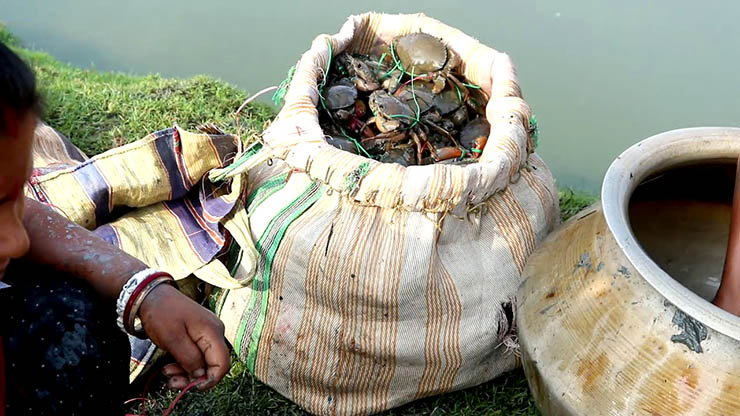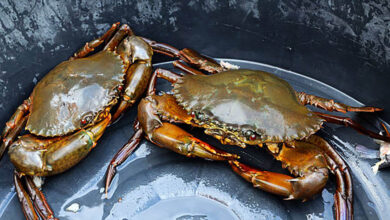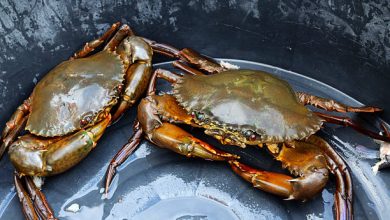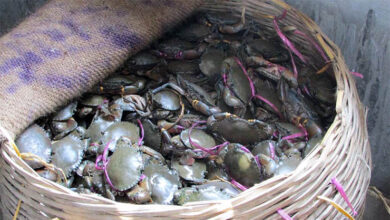
Scylla serrata, the mud crab, is an important species for aquaculture in Bangladesh because of the increasing demand in both the local and international markets. This species has gained great importance due to its strong flesh and high market value. S. serrata is commonly found in fully coastal and estuarine waters and mangrove habitats. Since aquaculture is an up-and-coming sector, identifying the present state of mud crab culture and feasibility in the country is imperative for improving sustainable production with increased economic benefit.
There are a number of major concerns in aquaculture of mud crab for fattening and soft-shell production. These are essential in understanding how to avail ourselves of the best in terms of sustainability in this sector.
Current condition of Mud Crab Culture:
Mud crab culture is still in its infancy in Bangladesh. Traditional fisheries have operated, but recent trends and directions in aquaculture are becoming clearer. The Ministry of Fisheries and Livestock has taken cognizance of the great potentiality of mud crab farming and initiated programs for its promotion as a livelihood option for coastal communities.
Production Level:
While the exact figures for the production of mud crab are not available, a general assumption is that it increases every year. The Bangladesh Fishery Department reports more crab culture farms are being set up, with particular additional units at Cox’s Bazar and Khulna, where brackish water is in plenty and excellent for S. serrata.
Market demand: The demand for mud crab is increasing significantly, especially in the leading countries like China, Vietnam, and Thailand. There is also a rise in local consumption in the local markets, which is acting as a positive indication for farmers and motivating them to further invest in mud crab culture Islam et al. 2019. The export market is also developing to be a very lucrative one where mud crab is considered to be an epicure
Mud Crab’s Current Issues and Shortcomings:
1. Disease Management
Problem: Mud crabs are susceptible to a number of diseases, including pathogenic bacteria and viruses that could wipe out an entire stock. In most cases, an outbreak results in huge economic losses for farmers.
Shortcoming: Most of the farms have not put proper measures that would help in controlling outbreaks concerning biosecurity.
Solution: Full biosecurity protocols regarding disease risks should be in place, complemented with regular health monitoring and vaccination strategies. Another important thing is teaching farmers the best practices concerning disease management.
2. Water Quality Management
Problem: Water quality is considered one of the factors in mud crab health and growth. Poor oxygen levels, high ammonia levels, and fluctuating salinity are some of the problems faced that depreciate the performance of productions.
Shortcoming: Poor practice in water management and poor tooling to monitor it hence poor water conditions.
Solution: Advanced aquatic water quality monitoring systems can be applied. Develop regularly monitored tests to maintain the stability of conditions. RAS could serve as one avenue to improve efficiency in water management.
3. Feeding Practices
Problem: Generally, mud crab nutrition is poorly understood. Hence, slow growth and poor feed conversion ratio.
Deficiency: Most farmers rely on using low-quality foods or remain uneducated about requirements that address nutritional needs.
Strategy: Nutritional requirement studies on mud crab would give way to nutritionally adequate feeds. Education on appropriate feeding strategies would spur growth performance improvement.
4. Habitat Destruction
Problem: The expansion in mud crab aquaculture poses a threat to environmental deterioration through demarcating areas, especially mangrove wetlands for pond construction.
Shortcoming: Unsustainable management practices contribute to adverse ecological impacts such as loss of biodiversity.
Solution: Encourage integrated mangrove restoration with sustainable farming practices to reduce environmental impacts. Training programs on Sustainable Aquaculture certification can enhance friendly environmental practices.
5. Market Access and Price Volatility
Problem: Farmers often face unpredictable access to the market and unstable prices, which put their profitability at risk.
Gaps: Poor access to market information and lack of cooperatives that could help farmers negotiate better prices.
Solution: The formation of cooperatives would provide them with better negotiation powers. Better market intelligence networks would enable them to make better decisions about uncontrollable price fluctuations.
6. Regulatory Issues
Problem Identification: Aquaculture legislations are sometimes inappropriate and senseless which make things more unfavorable to the new entrant farmers in the business.
Shortcoming: Ill-defined legislation may cause some legal implications due to failure to act in compliance with.
This will ensure that harmonization of regulatory processes and guidelines on the undertaking of aquaculture operations ensures that compliance will not hamper growth within the sector.
Sustainable Practices
Sustainable aquaculture is an important aspect that will ensure the long-term sustainability of mud crab farming.
- Integrated Farming Systems: Integration of mud crab culture with other aquaculture practices such as shrimp or fish farming improves productivity and efficient use of resources. The crab populations will be healthy if the mangrove ecosystems are conserved and appropriate practices for enhancing water quality are forwarded.
- Research and Development: Disease-resistant strains and better management practices for crabs will increase productivity and sustainability by investing in much-needed research to develop appropriate strains.
Future Prospects:
The future looks promising, provided the challenges facing mud crab culture in Bangladesh are addressed. In addition, policymakers should pay huge attention toward sustainability in aquaculture with a view toward environmental conservation and economic growth simultaneously. These collaborations will be able to build capacity through knowledge sharing, enhance farming practices, and lead to more strategic decision making.
Research and development investment will also lead to further improvement in breeding techniques and disease management so that mud crab culture resilient against environmental changes. With such increasing demand globally, Bangladesh has a bright future as a significant player in the export market for mud crabs.
Recommendations
Following feasibility and sustainability of mud crab culture in Bangladesh will be benefited with the following efforts:
- Capacity Building: Impart training programs regarding best practices in crab farming, disease management, and sustainable techniques of aquaculture to farmers.
- Infrastructure Development: Enhance transport and storage facilities to reduce post-harvest losses and improve market accessibility.
- Research Collaboration: Encourage partnerships among government agencies, academic institutions, and NGOs to promote research and innovations in crab farming.
- Policy Framework: Establish a comprehensive policy framework that incentivizes sustainable practices and protects the coastal ecosystem.
- Community Engagement: Engage local communities in decision-making processes for aquaculture development and allow their needs and insights to be taken into consideration.
These are setbacks and inadequacies that must be overcome with regard to mud crab aquaculture through multi-dimensional processes. Farming would, nevertheless, be more feasible and supportive if improvements are made in amendments related to disease management, water quality, feeding practices, environmental impacts, market access, and regulatory issues. It would need the integration of a researcher, farmers, and policy makers in bringing about innovative solutions as the key to the long-term success of this industry.
Farhana Islam
Agriculturist, Researcher
Fisheries Resource Management, CVASU



